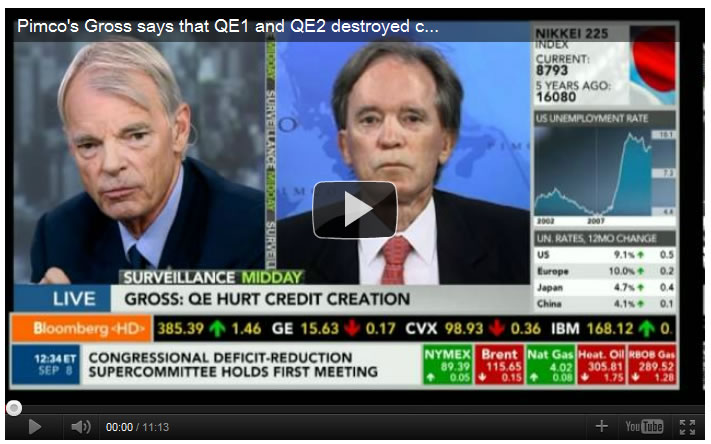PIMCO's Gross: QE1 and QE2 'Destroyed' Credit Creation
Interest-Rates / Credit Crisis 2011 Sep 08, 2011 - 05:52 PM GMTBy: Bloomberg
 Bill Gross of PIMCO appeared on Bloomberg Television's "Surveillance Midday" with Tom Keene this afternoon to discuss the impact of the Fed's asset purchases and the outlook for market reaction to tonight's speech by President Obama.
Bill Gross of PIMCO appeared on Bloomberg Television's "Surveillance Midday" with Tom Keene this afternoon to discuss the impact of the Fed's asset purchases and the outlook for market reaction to tonight's speech by President Obama.
Gross said that QE by the Fed "destroyed" credit creation, that he'd like to "see something bold" from Obama and that the markets will be "disappointed" if stimulus is below $300 billion.
Gross on credit creation:
"This is really a cost of credit versus a creation of credit type of argument. There is no doubt that by purchasing longer-dated Treasuries that they would probably lower the cost of credit. My argument is the creation of it would it be destroyed and has been destroyed over the past several years during QE1 and QE2. To bring the point specifically to what occurred the past several months with a two-year Treasury extension and the conditional freezing of interest rates at 25 basis points for two years, you have that basically flat yield curve destroys systemic leverage...Credit is basically destroyed in the process of lowering and freezing interest rates."
On his investment outlook:
"We have a number of suggestions in terms of what should be. What we think here in terms of what will be is that basically policy inaction and policy freezing from the standpoint of fiscal policy, which is where Bernanke wants to go in terms of his intended thrust going forward, but fiscal policy is basically frozen. Not just in the United States between Republicans and Democrats and the inaction in terms of the debt extension, but also in Europe between the north and south and who pays the bills. When you get in a period of time of high debt and when there comes a necessity to pay the piper in some form or fashion, there becomes significant arguments between interest parties. What we have seen now in euro land and the United States suggests the freezing of interest and inaction which provides no policy stimulus going forward."
On his policy recommendations for the U.S. economy:
"I will take a few chances here in terms of policy recommendations. Governor Mitt Romney, the Republican, did that, and I commend him for it over the past week. I think what we need to do is incent American companies to not only buy American, but to produce American jobs. Let's not necessarily go as far as recommending tariffs or walls in terms of imports, but let us talk about we do do as well to major corporations. The export-import thing in terms of what we have done for many years in terms of aircraft. And Boeing was a specific example. Why can't we apply that concept to smaller businesses in terms of providing financing? The infrastructure bank that might be proposed by President Obama tonight begins to do that, but I suggest we go beyond that and provide a bank for small and medium-sized as well as large U.S. corporations."
On what he'd like to hear from President Obama in tonight's address:
"I need to see some gusto. I don't think $300 billion really does it. When you break the program down about half of it is simply to continue existing programs. So we have less than 1% thrust in terms of new GDP types of programs, much of which is in 2012 and 2013 with the infrastructure bank. I would like to see something bold. I don't think we are going to see it, and I think the markets will be disappointed eventually and probably disappointed tomorrow morning if we see something at $300 billion or less."
On the yield curve flattening out and resulting in a loss of credit:
"What we have seen since 2008, and obviously this includes QE1, QE2, and the freezing the policy rates conditionally for the next two years, is that the growth size of the repo market which peaked in 2008 at about $6 trillion is now at $2.75 trillion. In terms repo alone, which is part of M3 and credit extension in terms of our banking system, we have seen the destruction of $3 trillion worth of repo over this period of time in which the Fed has basically brought down interest rates in the 2, 5, 7-year portion of the curve."
On how investors should react to the idea of the 30-Year bond being the new 10-Year note:
"I think they should look at it that way to the extent the two-year treasury is inert. Basically the first five years of the treasury curve is frozen, does not move that much. So those who are looking for higher yield, they basically have to move out to the 10-year area and perhaps to 30 years...We're in this different kind of world in which credit is extinguished, meaning that cash is held by banks."
Copyright © 2011 Bloomberg - All Rights Reserved Disclaimer: The above is a matter of opinion provided for general information purposes only and is not intended as investment advice. Information and analysis above are derived from sources and utilising methods believed to be reliable, but we cannot accept responsibility for any losses you may incur as a result of this analysis. Individuals should consult with their personal financial advisors.
© 2005-2022 http://www.MarketOracle.co.uk - The Market Oracle is a FREE Daily Financial Markets Analysis & Forecasting online publication.




